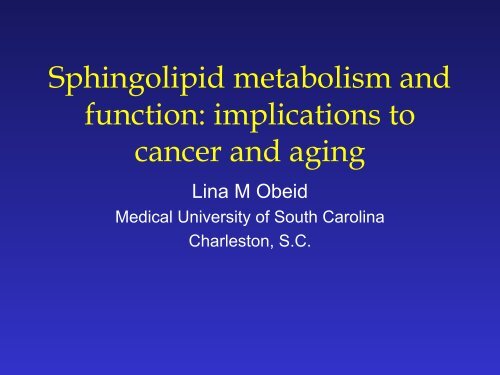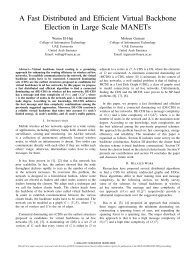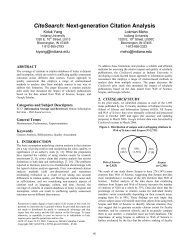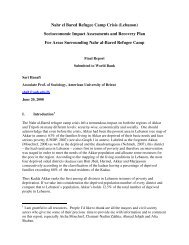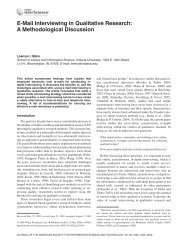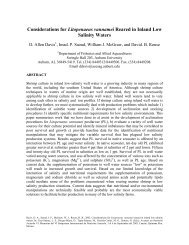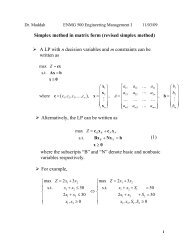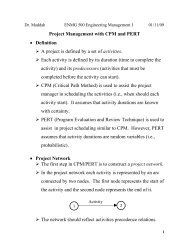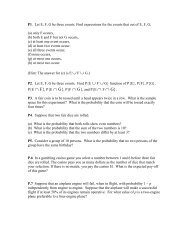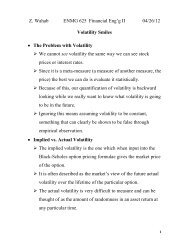Handout in pdf
Handout in pdf
Handout in pdf
You also want an ePaper? Increase the reach of your titles
YUMPU automatically turns print PDFs into web optimized ePapers that Google loves.
Sph<strong>in</strong>golipid metabolism and<br />
function: implications to<br />
cancer and ag<strong>in</strong>g<br />
L<strong>in</strong>a M Obeid<br />
Medical University of South Carol<strong>in</strong>a<br />
Charleston, S.C.
Overview<br />
Sph<strong>in</strong>golipid metabolism<br />
Sph<strong>in</strong>golipid function<br />
Sph<strong>in</strong>golipid mediated biology<br />
Cellular<br />
senescence<br />
Ag<strong>in</strong>g<br />
Cancer<br />
Telomerase Apoptosis<br />
Angiogenesis
Sph<strong>in</strong>golipid Metabolism
Sph<strong>in</strong>golipid function<br />
evidence for roles for sph<strong>in</strong>golipids <strong>in</strong><br />
signal<strong>in</strong>g and cell regulation<br />
<br />
<br />
A: Modular Action<br />
– Regulated metabolism of sph<strong>in</strong>golipids<br />
– Multiple bioactive sph<strong>in</strong>golipids; sph<strong>in</strong>gos<strong>in</strong>e, ceramide,<br />
sph<strong>in</strong>gos<strong>in</strong>e-1 phosphate, and others.<br />
– Identification of targets for sph<strong>in</strong>golipid action: mechanisms of<br />
action e.g. k<strong>in</strong>ases, phosphatases and receptors.<br />
– Decipher<strong>in</strong>g mechanisms of regulation of sph<strong>in</strong>golipid metabolism.<br />
– Molecular genetics of sph<strong>in</strong>golipid function <strong>in</strong> yeast.<br />
B: Other Functions<br />
– Critical membrane components: required for viability <strong>in</strong> yeast and<br />
mammalian cells.<br />
– Enzymes of sph<strong>in</strong>golipid metabolism as targets for anti fungals and<br />
antibiotics<br />
– Cell cell <strong>in</strong>teractions<br />
– Receptors for various ligands and tox<strong>in</strong>s
Cellular Senescence:<br />
a model to study ag<strong>in</strong>g<br />
Inverse correlation between age and life<br />
span of cells <strong>in</strong> culture<br />
Correlation between life span of species<br />
and its cells <strong>in</strong> culture<br />
Mortal cells have a f<strong>in</strong>ite life span <strong>in</strong><br />
culture (limited population doubl<strong>in</strong>gs)
Biology of Cellular Senescence<br />
Inability to proliferate<br />
Inability to undergo DNA synthesis<br />
Telomere shorten<strong>in</strong>g<br />
Senescence is dom<strong>in</strong>ant<br />
Resembles a state of term<strong>in</strong>al<br />
differentiation
Ceramide Levels and Sph<strong>in</strong>gomyel<strong>in</strong>ase<br />
Activity Increase <strong>in</strong> Senescent Cells
Ceramide Induces a Senescent Phenotype<br />
<strong>in</strong> Human Diploid fibroblasts
Ceramide and cellular<br />
senescence<br />
Ceramide levels and SMase activity <strong>in</strong>crease<br />
when cells become senescent<br />
Ceramide <strong>in</strong>duces a senescent phenotype<br />
morphologically<br />
biochemically (<strong>in</strong>hibits cell cycle progression, <strong>in</strong>hibits<br />
the PKC/PLD pathway, <strong>in</strong>duces Rb dephosphorylation,<br />
<strong>in</strong>hibits AP1 activity…)
Telomeres<br />
<br />
The ends of eukaryotic chromo-somes<br />
are capped by short G-rich sequences<br />
(telomeres) that are tandemly<br />
repeated for several hundred to<br />
thousand base pairs.<br />
<br />
In humans the telomeric repeat is<br />
TTAGGG.<br />
<br />
Telomeres prevent chromosomal<br />
degradation, end-to-end fusion, and<br />
chromosomal rearrangements.<br />
Human telomeres shorten with each<br />
cell division.<br />
<br />
Telomeric shorten<strong>in</strong>g is thought to<br />
function as a molecular clock that<br />
triggers senescence and crisis.<br />
Haber, D.A. NEJM 332 (14):955 , 1995
Background on Telomerase<br />
<br />
Telomerase is a ribonucleoprote<strong>in</strong> enzyme<br />
complex that adds telomeric repeats<br />
(TTAGGG) n to the ends of chromosomes.<br />
<br />
Telomerase activity is detected <strong>in</strong> malignant<br />
cells, immortalized cells, and germ cells, and is<br />
not detected <strong>in</strong> most somatic cells.<br />
It has been shown to be over expressed <strong>in</strong> 85-<br />
90% of human cancers.<br />
<br />
It is not sufficient to cause neoplasia on its<br />
own. Its presence enables malignant cells to<br />
ma<strong>in</strong>ta<strong>in</strong> telomere length, allow<strong>in</strong>g <strong>in</strong>f<strong>in</strong>ite<br />
replicative capacity.<br />
Buys, CHCM. NEJM 342 (17):1282 (2000)<br />
<br />
Increased telomerase activity has been<br />
suggested to offer protection aga<strong>in</strong>st apoptosis
The Human Telomerase Ribonucleoprote<strong>in</strong> Complex<br />
The human telomerase complex<br />
consists of:<br />
• hTERT (the catalytic reverse<br />
transcriptase subunit)<br />
• hTR (the RNA template)<br />
• Telomerase associated prote<strong>in</strong>s:<br />
TEP1 & p23/hsp90<br />
• prote<strong>in</strong> components of snoRNPs<br />
<strong>in</strong>clud<strong>in</strong>g dysker<strong>in</strong><br />
• DNA-b<strong>in</strong>d<strong>in</strong>g prote<strong>in</strong>s TRF-1 & TRF-2<br />
• TRF-1 associated prote<strong>in</strong>s TIN2 &<br />
tankyrase<br />
• other associated prote<strong>in</strong>s<br />
Estimated molecular mass > 1000 kDA<br />
Shay, J.W. and Wright, W.E. Science 286;2284-2285 (1999).
Ceramide Inhibits Telomerase<br />
Activity<br />
OH<br />
1 5<br />
2<br />
HO 3<br />
4<br />
N<br />
H<br />
(2S,3R)<br />
18<br />
16 '<br />
O<br />
D- erythro-C 16 -Ceramide<br />
OH<br />
1 5<br />
2<br />
HO 3<br />
4<br />
N<br />
H<br />
(2S,3R)<br />
18<br />
16 '<br />
O<br />
D- erythro-4,5-dihydro-C 16 -Ceramide
Ceramide causes a decrease <strong>in</strong><br />
telomerase mRNA
Ceramide <strong>in</strong>hibits telomerase<br />
transcription
Ceramide mediates ubiquit<strong>in</strong>ation<br />
and degradation of c-Myc
CONCLUSIONS<br />
<br />
<br />
<br />
<br />
Ceramide is a possible upstream regulator of telomerase<br />
Inhibition of telomerase by ceramide <strong>in</strong>volves rapid proteolysis<br />
of c-Myc transcription factor (by <strong>in</strong>creased ubiquit<strong>in</strong>ation),<br />
which decreases the hTERT promoter activity, lead<strong>in</strong>g to<br />
decreased transcription and telomerase activity<br />
Increased endogenous ceramide levels <strong>in</strong> response to various<br />
stimuli such as chemotherapy might be a potential therapeutic<br />
modality<br />
Ceramide-<strong>in</strong>duced telomerase <strong>in</strong>hibition and telomere length<br />
reduction is important for growth <strong>in</strong>hibition and senescence<br />
Ogretmen et al., J. Biol. Chem. 276:32506-32514, 2001
Role of Ceramide <strong>in</strong> Apoptosis<br />
• A grow<strong>in</strong>g body of evidence is po<strong>in</strong>t<strong>in</strong>g to important roles of<br />
ceramide <strong>in</strong> apoptosis.<br />
• This evidence comes from studies show<strong>in</strong>g:<br />
1. Most apoptotic stimuli <strong>in</strong>duce ceramide formation with<br />
appropriate k<strong>in</strong>etics; multiple mechanisms.<br />
2. Exogenous and endogenous ceramides are sufficient to<br />
<strong>in</strong>duce apoptosis<br />
4. Endogenous ceramides are necessary<br />
5. Cellular mechanisms are <strong>in</strong>creas<strong>in</strong>gly provid<strong>in</strong>g l<strong>in</strong>ks<br />
between ceramide metabolism, its action, and other key<br />
components of apoptosis (bcl-x, bcl-2, upstream caspases,<br />
downstream caspases, p53, ROI’s, mitochondria)<br />
6. Yeast models of <strong>in</strong>volvement of sph<strong>in</strong>golipids <strong>in</strong> stress<br />
responses
Bax<br />
<br />
S<strong>in</strong>gomyel<strong>in</strong>ase<br />
Ceramide
Bax<br />
Sph<strong>in</strong>gomyel<strong>in</strong>ase<br />
Ceramide
Ceramide and Mitochondria<br />
1. Activation of sph<strong>in</strong>gomyel<strong>in</strong>ase (SMase) is<br />
sandwiched between the action of upstream<br />
caspases and downstream caspases.<br />
2. Exogenous ceramides specifically activate<br />
downstream caspases and not upstream<br />
caspases; also, ceramides <strong>in</strong>duce cytochrome<br />
c release.<br />
3. Activation of SMase is dependent on<br />
ROIs/drop <strong>in</strong> GSH.<br />
4. New data on a more <strong>in</strong>timate connection.
Neutral sph<strong>in</strong>gomyel<strong>in</strong>ase activity <strong>in</strong><br />
MAMs from liver<br />
Acid P-ase<br />
umole/mg/hr<br />
F 0<br />
F 1<br />
ATPase<br />
umole/mg/hr<br />
NSMase<br />
nmol/mg/hr<br />
Acid Smase<br />
nmol/mg/hr<br />
H<br />
3.77<br />
13.2<br />
8.9<br />
133.9<br />
S<br />
1.67<br />
-<br />
4.7<br />
14.35<br />
M<br />
12.9<br />
28.5<br />
20.6<br />
489<br />
PM<br />
5.2<br />
35<br />
8.24<br />
295<br />
MAM 2.6<br />
18<br />
23.5<br />
111.7<br />
Table 2: Enzyme assays <strong>in</strong> the different cellular fractions.<br />
H = Homogenate fraction follow<strong>in</strong>g low sp<strong>in</strong> centrifugation (1000 g x 5’).<br />
S = Post mitochondrial supernatant. M = crude mitochondria.<br />
PM = pure mitochondria isolated follow<strong>in</strong>g percoll gradient.<br />
MAM = mitochondrial associated membranes.
Ceramide Levels <strong>in</strong> Liver<br />
Mitochondria<br />
200<br />
B Ceramide<br />
control<br />
Ceramide pmoles/pi<br />
150<br />
100<br />
50<br />
37Þ C<br />
bSMase<br />
0<br />
H S M PM MAM
Construction of bSMase-GFP vectors with target<strong>in</strong>g signals<br />
to different <strong>in</strong>tracellular compartments<br />
pCMV/myc
Cellular localization of the bSMase-GFP fusion prote<strong>in</strong><br />
<strong>in</strong> MCF7 cells<br />
plasma membrane cytoplasm Mitochondria<br />
Golgi ER Nuclei<br />
GFP Mitotracker Overlay
Increase of SMase activity <strong>in</strong> MCF7 cells<br />
transfected with the six bSMase-GFP vectors<br />
Specific activity (nmol/h/mg)<br />
6<br />
4<br />
2<br />
0<br />
PM-control<br />
PM-bSMase<br />
* * *<br />
12 24 48 72 96<br />
Time (h)<br />
50<br />
40<br />
30<br />
20<br />
10<br />
0<br />
Cyto-control<br />
Cyto-bSMase<br />
*<br />
* *<br />
12 24 48 72 96<br />
Time (h)<br />
30<br />
20<br />
10<br />
0<br />
Mito-control<br />
Mito-bSMase<br />
*<br />
*<br />
12 24 48 72 96<br />
Time (h)<br />
Specific activity (nmol/h/mg)<br />
40<br />
30<br />
20<br />
10<br />
0<br />
Golgi-control<br />
Golgi-bSMase<br />
*<br />
*<br />
* *<br />
12 24 48 72 96<br />
Time (h)<br />
600<br />
400<br />
200<br />
0<br />
ER-control<br />
ER-bSMase<br />
* *<br />
* * *<br />
12 24 48 72 96<br />
Time (h)<br />
40<br />
30<br />
20<br />
10<br />
0<br />
Nucleus-control<br />
Nucleus-bSMase<br />
*<br />
* *<br />
12 24 48 72 96<br />
Time (h)
Increase of ceramide levels <strong>in</strong> MCF7 cells transfected<br />
with the bSMase-GFP constructs<br />
PM-control<br />
Cyto-control<br />
Mito-control<br />
Ceramide (% of control)<br />
130<br />
110<br />
90<br />
70<br />
50<br />
PM-bSMase<br />
12 24 48 72<br />
Time (h)<br />
130<br />
110<br />
90<br />
70<br />
50<br />
Cyto-bSMase<br />
12 24 48 72<br />
Time (h)<br />
150<br />
130<br />
110<br />
90<br />
70<br />
50<br />
Mito-bSMase<br />
* *<br />
12 24 48 72<br />
Time (h)<br />
ER-control<br />
Golgi-control<br />
Nucleus-control<br />
Ceramide (% of control)<br />
300<br />
250<br />
200<br />
150<br />
100<br />
50<br />
ER-bSMase<br />
*<br />
*<br />
*<br />
12 24 48 72<br />
Time (h)<br />
200<br />
150<br />
100<br />
50<br />
Golgi-bSMase<br />
*<br />
*<br />
12 24 48 72<br />
Time (h)<br />
150<br />
125<br />
100<br />
75<br />
50<br />
Nucleus-bSMase<br />
12 24 48 72<br />
Time (h)
30<br />
20<br />
10<br />
0<br />
Mitochondrial target<strong>in</strong>g of the<br />
bSMase <strong>in</strong>duces cell death<br />
A<br />
30<br />
Mito-control<br />
Mito-bSMase<br />
25<br />
20<br />
15<br />
10<br />
5<br />
0<br />
24 48 72<br />
Time (h)<br />
B<br />
Dead cells<br />
(% of total transfected cells)<br />
PM-control<br />
PM-bSMase<br />
Cyto-control<br />
Cyto-bSMase<br />
Mito-control<br />
Mito-bSMase<br />
ER-control<br />
ER-bSMase<br />
Golgi-control<br />
Golgi-bSMase<br />
Nuc-control<br />
Nuc-bSMase
verexpression of the Mito-bSMase-D295G mutant does<br />
not cause elevation of SMase activity , ceramide levels<br />
or cell death.<br />
20<br />
15<br />
10<br />
5<br />
A B C<br />
150<br />
25<br />
125<br />
100<br />
75<br />
* *<br />
20<br />
15<br />
10<br />
Ceramide (% of control)<br />
5<br />
Dead cells<br />
(% of total transfected cells)<br />
*<br />
Specific activity (nmol/h/mg)<br />
control<br />
Mito-bSMase<br />
Mito-bSMase-D295G<br />
Mito-control<br />
Mito-bSMase<br />
Mito-bSMase-D295G<br />
Mito-control<br />
Mito-bSMase<br />
Mito-bSMase-D295G<br />
0<br />
50<br />
0
Bax<br />
Sph<strong>in</strong>gomyel<strong>in</strong>ase<br />
Ceramide
Summery<br />
Evidence for a mitochondrial pool of<br />
ceramide<br />
Evidence for a MAM pool of SMase<br />
Only <strong>in</strong>creases <strong>in</strong> mitochondrial<br />
ceramide <strong>in</strong>duce the apoptotic program
Sph<strong>in</strong>gomyel<strong>in</strong><br />
Glycolipids<br />
GCS<br />
Senescence<br />
SMase<br />
CERAMIDE<br />
+ +<br />
CDase<br />
Inhibition of Telomerase<br />
SPH<br />
Apoptosis<br />
-<br />
De novo synthesis<br />
SPH-1-P<br />
+<br />
Proliferation<br />
Migration<br />
Angiogenesis
Acknowledgements<br />
Coworkers<br />
Cungui Mao<br />
Ruijuan Xu<br />
Helene Birbes<br />
Jackie Kraveka<br />
Korey Johnson<br />
Heather Greer<br />
Kashelle Othersen<br />
Tarek Taha<br />
Mark Venable<br />
Collaborators<br />
Yusuf Hannun<br />
Besim Ogretmen<br />
Alicia Bielawska<br />
Zdzislaw Szulc<br />
Julnar Usta<br />
Adm<strong>in</strong>istrative Support<br />
Kathy Wiita<br />
National Institutes of Ag<strong>in</strong>g<br />
Veteran’s Adm<strong>in</strong>istration Merit Award<br />
Paul Beeson Physician Faculty <strong>in</strong> Ag<strong>in</strong>g Award
Web site<br />
www.musc.edu/bcmb/ceramide


